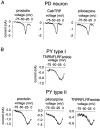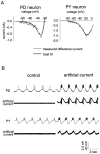Modulators with convergent cellular actions elicit distinct circuit outputs
- PMID: 11356892
- PMCID: PMC6762692
- DOI: 10.1523/JNEUROSCI.21-11-04050.2001
Modulators with convergent cellular actions elicit distinct circuit outputs
Abstract
Six neuromodulators [proctolin, Cancer borealis tachykinin-related peptide Ia, crustacean cardioactive peptide (CCAP), red pigment-concentrating hormone, TNRNFLRFamide, and pilocarpine] converge onto the same voltage-dependent inward current in stomatogastric ganglion (STG) neurons of the crab C. borealis. We show here that each of these modulators acts on a distinct subset of pyloric network neurons in the STG. To ask whether the differences in cell targets could account for their differential effects on the pyloric rhythm, we systematically compared the motor patterns produced by proctolin and CCAP. The motor patterns produced in proctolin and CCAP differed quantitatively in a number of ways. Proctolin and CCAP both act on the lateral pyloric neuron and the inferior cardiac neuron. Proctolin additionally acts on the pyloric dilator (PD) neurons, the pyloric (PY) neurons, and the ventricular dilator neuron. Using the dynamic clamp, we introduced an artificial peptide-elicited current into the PD and PY neurons, in the presence of CCAP, and converted the CCAP rhythm into a rhythm that was statistically similar to that seen in proctolin. This suggests that the differences in the network effects of these two modulators can primarily be attributed to the known differential distributions of their receptors onto distinct subsets of neurons, despite the fact that they activate the same current.
Figures







Similar articles
-
Modulation of stomatogastric rhythms.J Comp Physiol A Neuroethol Sens Neural Behav Physiol. 2009 Nov;195(11):989-1009. doi: 10.1007/s00359-009-0483-y. Epub 2009 Oct 11. J Comp Physiol A Neuroethol Sens Neural Behav Physiol. 2009. PMID: 19823843 Review.
-
Graded Transmission without Action Potentials Sustains Rhythmic Activity in Some But Not All Modulators That Activate the Same Current.J Neurosci. 2018 Oct 17;38(42):8976-8988. doi: 10.1523/JNEUROSCI.2632-17.2018. Epub 2018 Sep 5. J Neurosci. 2018. PMID: 30185461 Free PMC article.
-
Projection neurons with shared cotransmitters elicit different motor patterns from the same neural circuit.J Neurosci. 2000 Dec 1;20(23):8943-53. doi: 10.1523/JNEUROSCI.20-23-08943.2000. J Neurosci. 2000. PMID: 11102505 Free PMC article.
-
Multiple peptides converge to activate the same voltage-dependent current in a central pattern-generating circuit.J Neurosci. 2000 Sep 15;20(18):6752-9. doi: 10.1523/JNEUROSCI.20-18-06752.2000. J Neurosci. 2000. PMID: 10995818 Free PMC article.
-
Frequency control of a slow oscillatory network by a fast rhythmic input: pyloric to gastric mill interactions in the crab stomatogastric nervous system.Ann N Y Acad Sci. 1998 Nov 16;860:226-38. doi: 10.1111/j.1749-6632.1998.tb09052.x. Ann N Y Acad Sci. 1998. PMID: 9928315 Review.
Cited by
-
A small-systems approach to motor pattern generation.Nature. 2002 May 16;417(6886):343-50. doi: 10.1038/417343a. Nature. 2002. PMID: 12015615 Free PMC article. Review.
-
Modulation of stomatogastric rhythms.J Comp Physiol A Neuroethol Sens Neural Behav Physiol. 2009 Nov;195(11):989-1009. doi: 10.1007/s00359-009-0483-y. Epub 2009 Oct 11. J Comp Physiol A Neuroethol Sens Neural Behav Physiol. 2009. PMID: 19823843 Review.
-
Mapping circuit dynamics during function and dysfunction.Elife. 2022 Mar 18;11:e76579. doi: 10.7554/eLife.76579. Elife. 2022. PMID: 35302489 Free PMC article.
-
Designing tools for assumption-proof brain mapping.Neuron. 2014 Sep 17;83(6):1239-41. doi: 10.1016/j.neuron.2014.09.004. Neuron. 2014. PMID: 25233303 Free PMC article. Review.
-
Neuromodulation to the Rescue: Compensation of Temperature-Induced Breakdown of Rhythmic Motor Patterns via Extrinsic Neuromodulatory Input.PLoS Biol. 2015 Sep 29;13(9):e1002265. doi: 10.1371/journal.pbio.1002265. eCollection 2015. PLoS Biol. 2015. PMID: 26417944 Free PMC article.
References
-
- Bidaut M. Pharmacological dissection of pyloric network of the lobster stomatogastric ganglion using picrotoxin. J Neurophysiol. 1980;44:1089–1101. - PubMed
-
- Christie AE, Skiebe P, Marder E. Matrix of neuromodulators in neurosecretory structures of the crab, Cancer borealis. J Exp Biol. 1995;198:2431–2439. - PubMed
Publication types
MeSH terms
Substances
Grants and funding
LinkOut - more resources
Full Text Sources
